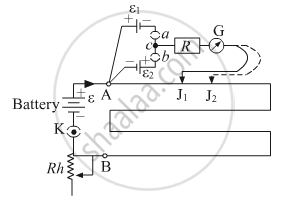Advertisements
Advertisements
प्रश्न
State the underlying principle of a potentiometer ?
उत्तर
Principle of potentiometer: When a steady current flows through it, the potential difference across a uniform wire is directly proportional to the length of the part across which the potential is measured.
संबंधित प्रश्न
In the given circuit, with steady current, calculate the potential drop across the capacitor and the charge stored in it.

Draw a labelled circuit diagram of a potentiometer to measure the internal resistance ‘r’ of a cell. Write the working formula (derivation is not required).
A student uses the circuit diagram of a potentiometer as shown in the figure
(a) for a steady current I passing through the potentiometer wire, he gets a null point for the cell ε1. and not for ε2. Give the reason for this observation and suggest how this difficulty can be resolved.
(b) What is the function of resistance R used in the circuit? How will the change in its value affect the null point?
(c) How can the sensitivity of the potentiometer be increased?

When the balance point is obtained in the potentiometer, a current is drawn from ______.
The potentiometer is more sensitive, when ______.
A potentiometer is an ideal device for measuring potential difference because ______.
Select the WRONG statement:
Specific resistance of a conductor increase with.
The instrument among the following which measures the e.m.f of a cell most accurately is ______
Two identical thin metal plates has charge q1 and q2 respectively such that q1 > q2. The plates were brought close to each other to form a parallel plate capacitor of capacitance C. The potential difference between them is ______.
